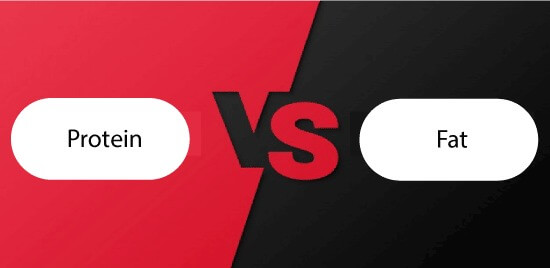Difference between Protein and Fat
The human body requires energy for performing daily activities that are fulfilled by fats and protein. Fats and protein are the main components of nutrition and energy. They are obtained from food. Let's see how they differ from each other.

Protein
Protein is one of the most abundant and important components of the body. The word protein is derived from the Greek word "proteios" which means primary. Proteins comprise carbon, hydrogen, oxygen, and nitrogen. Proteins are nitrogenous food products whose components are called amino acids.
There are two types of amino acids, which are essential amino acids and non-essential acids. The essential Amino acids are threonine, histidine, lysine, leucine, etc. Non-essential acids are Asparagine, cystine, proline, arginine glycine, etc.
Classification of protein
i) Based on the complexity and structure of the protein.
- Simple protein: Those proteins which are made up of only amino acids are called simple proteins. For example, albumin of egg, zein of corn, and gliadin of wheat.
- Conjugated protein: Conjugated protein means a protein consisting of some non-protein molecules. For example, Haemoglobin is made of iron and protein.
- Derived protein: This protein consists of a partial breakdown of the native protein. For example, proteoses, polypeptides.
ii) Based on the quality
- Complete protein: A protein that contains a sufficient amount of amino acids is called a complete protein. For example, all poultry products and soybean.
- Incomplete protein: Proteins that contain some amount of amino acids for growth and maintenance are called incomplete proteins, for example, pulses, cereals, vegetables, etc.
Daily requirements of protein:
- For adults, 1 kg body weight needs 1 gram of protein. Consider if bodyweight is 45 kg, then the daily requirement of protein for the body is 45 grams.
- For children, 1 kg body weight needs 2.5 grams of protein. Consider if bodyweight is 10 kg, then the daily requirement of protein for the body is 25 grams.
The function of protein:
- It helps to produce enzymes, immunoglobulin, hormones, and plasma.
- If there is a lack of carbohydrates and fats in the body, then at that time, protein is the main source of energy.
- Blood contains proteins for different functions, including blood clotting and antibodies.
- The material needed for cell formation and to replace the cell is supplied by proteins.
- Protein is helpful in producing antibodies.
Fats
Fat is a component of nutrition. It gives energy to the body. For a healthy, balanced diet, eat a small amount of food that contains fats as more fats are not good for the human body. Fat is a source of fatty acids which the body cannot make itself. The human body requires 15-20% calories from fat out of the total calories needed per day. More amount of fats is dangerous to the human body. This leads to a condition called obesity.
Types of fats
- Visible fats: These are the fats that are separate from the natural source. This fat is visible to the human eye. Therefore it is easy to estimate their intake in the daily diet. For example, ghee, as it is visible to the eyes and the quantity of ghee can be estimated.
- Invisible fats: This fat is invisible to the human eye. Therefore it is difficult to estimate their intake in the daily diet. For example, daliya, pulses, nuts, milk. The fats in the pulses, nuts, daliya are invisible to the eyes, and it is also not possible to estimate the amount of fat consumed by a person.
- Saturated fats: It consists of fatty acids and glycerol. This fat is derived from animal fat. This fat becomes solid at low temperatures or in a cold environment. This fat melts at high temperatures or in a hot environment. For example, butter, ghee, etc.
- Unsaturated fat: This fat consists of unsaturated fatty acids and glycerol. This is obtained from vegetable sources. There is no effect of the environment on them. For example, arachnoid oil, sunflower oil, etc.
Functions of fats
- Energy: Fats are a source of energy.
- Protein sparing action: Dietary fat intake allows the protein to perform its main function of growth and maintenance.
- Protection of vital organs: Fat provides protection to important organs such as the heart, Kidney, etc.
- Absorption of fat-soluble vitamins: Fats are important for the absorption of fat-soluble vitamins A, D, E & K.
- Satisfy value: It gives a feeling of fullness to the stomach.
Sources of fat
- Animal fat: Fat that is derived from animal products is known as animal fat. For example, ghee, butter, milk, cheese.
- Vegetable fat: Fat that is derived from vegetables is called vegetable fat. For example, coconut, sunflower, almond, nuts, etc.
Effects of deficiency of fats
- Fat deficiency can lead to a deficiency of fat-soluble vitamins that can affect children's growth and weight.
- The deficiency of essential fatty acids in the diet leads to a condition called toad cell.
Difference between protein and fat
| Protein |
Fat |
| Proteins contain components amino acids. |
Fat contains fatty acids. |
| The daily need for protein for the body is 1 gram per kg for adults and 2.5 gram per kg for children. |
Daily need for fat is 20 to 30% of the total calories needed per day. |
| Proteins are goods for humans as they help in muscles building. |
More fats are not good for the human body. |
| Protein is helpful in producing antibodies. |
Fat does not help in the production of antibodies. |
| Types of proteins are conjugated protein, simple protein, and derived protein. |
Types of fats are visible fats, invisible fats, saturated fats, and unsaturated fats. |
| Examples: Pulses, meat, eggs, etc. |
Examples: Oil, ghee, butter, cheese, etc. |
|

 For Videos Join Our Youtube Channel: Join Now
For Videos Join Our Youtube Channel: Join Now










